View in other NatureServe Network Field Guides
NatureServe
Montana
Utah
Wyoming
Idaho
Wisconsin
British Columbia
South Carolina
Yukon
California
New York
Beck Water-marigold - Bidens beckii
Other Names:
Megalodonta beckii
State Rank Reason (see State Rank above)
Known from ten occurrences in the western valleys of the state, including 6 moderate to large populations and one historical occurrence from Salmon Lake dating to 1937. However, the species may be more abundant in the state than what current data suggests. Threats and impacts to populations in Montana include boating activity, lake shore development, aquatic weeds and use of aquatic herbicides.
General Description
Beck Water-marigold is an aquatic perennial herb with lower stems that are submerged and upper portions usually emergent. Submerged leaves are opposite, sessile, and divided into numerous thread-like segments. The lance-shaped, emergent leaves are sessile, opposite, and 2-4 cm long with sharply toothed margins. Solitary flower heads are borne on the ends of the emergent stems. Each head has 2 series of involucral bracts, with the outer being larger and leafier than the inner bracts. The yellow rays are 1-2 cm long, and the disk flowers are also yellow. Achenes are 10-14 mm long and nearly round in cross-section, with 3-6 long, slender, barbed awns at the tops.
Phenology
Flowering in late August-September.
Diagnostic Characteristics
In Montana
Bidens species have opposite leaves, involucral bracts of 2 types, awned seeds that catch your clothing, and grow in wetland habitats. Several species lack ray florets.
Beck Water-marigold -
Bidens beckii, SOC
*Life Span: Perennial
*Leaves: Of two types. Submerged leaves are dissected into thread-like segments. Emergent leaves are simple and toothed.
*Flower Heads: Composed of disc and ray florets.
*Pappus: Of 2-6 awns.
*Habitat: Aquatic.
Devil's Beggarticks -
Bidens frondosa*Life Span: Annual.
*Leaves: Pinnately divided and with a distinct petiole.
*Flower Heads: Composed of disc florets; ray florets absent or inconspicuous. Outer phyllaries are 5-8 mm long.
*Pappus: With 2 awns.
*Habitat: Wet or moist places that may become temporarily inundated.
Tall Bur-marigold -
Bidens vulgata*Life Span: Annual.
*Leaves: Pinnately divided and with a distinct petiole.
*Flower Heads: Composed only of disc florets; ray florets absent. Outer phyllaries are 10-16 mm long.
*Pappus: With 2 awns.
*Habitat: Wet or moist places that may become temporarily inundated.
Nodding Beggarticks -
Bidens cernua*Life Span: Annual.
*Leaves: Simple or shallowly lobed and toothed. Petioles are short and distinct or sessile and winged.
*Flower Heads: Composed of disc and ray florets.
*Pappus: Usually with 4 awns.
*Habitat: Wet or moist places that may become temporarily inundated.
Three-lobe Beggarticks -
Bidens comosa*Life Span: Annual.
*Leaves: Simple or shallowly lobed and toothed. Petioles are short and distinct or sessile and winged.
*Flower Heads: Composed only of disc florets though sometimes with inconspicuous ray florets.
*Pappus: Usually with 3 awns.
*Habitat: Wet or moist places that may become temporarily inundated.
Species Range
Montana Range
Range Descriptions
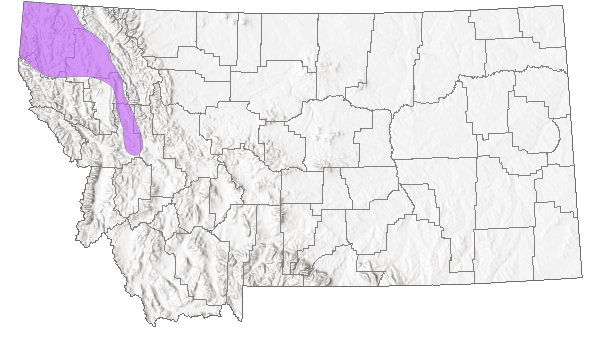
 Native
Native
Range Comments
BC to QC south to OR, MT, MO, PA and NY (Lesica et al. 2012. Manual of Montana Vascular Plants. BRIT Press. Fort Worth, TX).
Observations in Montana Natural Heritage Program Database
Number of Observations: 254
(Click on the following maps and charts to see full sized version)
Map Help and Descriptions
Relative Density
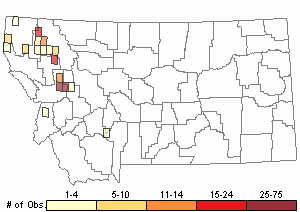
Recency
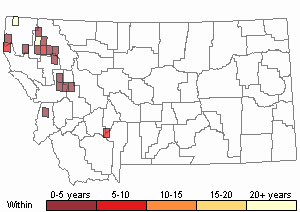

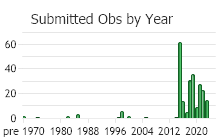
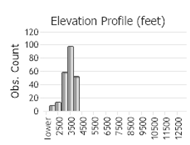 (Observations spanning multiple months or years are excluded from time charts)
(Observations spanning multiple months or years are excluded from time charts)
Habitat
Still or slow-moving water of lakes, rivers, and sloughs in the valleys, 0.1-3 m deep.
Ecological Systems Associated with this Species
Ecology
POLLINATORS The following animal species have been reported as pollinators of this plant species or its genus where their geographic ranges overlap:
Bombus griseocollis and
Bombus impatiens (Plath 1934, Colla and Dumesh 2010).
Stewardship Responsibility
Threats or Limiting Factors
STATE THREAT SCORE REASON
Reported threats to Montana’s populations of Beck Water-marigold are due to presence of non-native American Water-lily at some sites. American Water-lily has large, floating leaves, and is a strong competitor for light on the surface of standing water. Partially submerged Beck Water-marigold plants are relatively vulnerable to direct competition for light, and populations are unlikely to establish where habitat is displaced by non-natives (MTNHP Threat Assessment 2021).
References
- Literature Cited AboveLegend:
 View Online Publication
View Online Publication Colla, S.R. and S. Dumesh. 2010. The bumble bees of southern Ontario: notes on natural history and distribution. Journal of the Entomological Society of Ontario 141:39-68.
Colla, S.R. and S. Dumesh. 2010. The bumble bees of southern Ontario: notes on natural history and distribution. Journal of the Entomological Society of Ontario 141:39-68. Flora of North America Editorial Committee (FNA). 2006. Flora of North America North of Mexico. Vol. 21. Magnoliophyta: Asteridae (in part): Asteraceae, part 3. Oxford Univ. Press, New York. xxii + 616 pp.
Flora of North America Editorial Committee (FNA). 2006. Flora of North America North of Mexico. Vol. 21. Magnoliophyta: Asteridae (in part): Asteraceae, part 3. Oxford Univ. Press, New York. xxii + 616 pp. Hitchcock, C.L. and A. Cronquist. 2018. Flora of the Pacific Northwest: An Illustrated Manual. Second Edition. Giblin, D.E., B.S. Legler, P.F. Zika, and R.G. Olmstead (eds). Seattle, WA: University of Washington Press in Association with Burke Museum of Natural History and Culture. 882 p.
Hitchcock, C.L. and A. Cronquist. 2018. Flora of the Pacific Northwest: An Illustrated Manual. Second Edition. Giblin, D.E., B.S. Legler, P.F. Zika, and R.G. Olmstead (eds). Seattle, WA: University of Washington Press in Association with Burke Museum of Natural History and Culture. 882 p. Lesica, P., M.T. Lavin, and P.F. Stickney. 2012. Manual of Montana Vascular Plants. Fort Worth, TX: BRIT Press. viii + 771 p.
Lesica, P., M.T. Lavin, and P.F. Stickney. 2012. Manual of Montana Vascular Plants. Fort Worth, TX: BRIT Press. viii + 771 p. MTNHP Threat Assessment. 2021. State Threat Score Assignment and Assessment of Reported Threats from 2006 to 2021 for State-listed Vascular Plants. Botany Program, Montana Natural Heritage Program, Helena, Montana.
MTNHP Threat Assessment. 2021. State Threat Score Assignment and Assessment of Reported Threats from 2006 to 2021 for State-listed Vascular Plants. Botany Program, Montana Natural Heritage Program, Helena, Montana. Plath, O.E. 1934. Bumblebees and their ways. New York, NY: Macmillan Company. 201 p.
Plath, O.E. 1934. Bumblebees and their ways. New York, NY: Macmillan Company. 201 p.
- Additional ReferencesLegend:
 View Online Publication
View Online Publication
Do you know of a citation we're missing? Bissell, J.K. & C.W. Bier. 1987 Dec 30. Presque Isle State Park: Botanical Survey and Natural Community Classification. U87BIS02.
Bissell, J.K. & C.W. Bier. 1987 Dec 30. Presque Isle State Park: Botanical Survey and Natural Community Classification. U87BIS02. Fairbrothers, D.E. et al. 1965. Aquatic Vegetation of New Jersey. Rutgers Univ. Ext. Serv. College of Agriculture. Ext. Bull. 382. Camden, New Jersey, USA. B65FAI01PAUS.
Fairbrothers, D.E. et al. 1965. Aquatic Vegetation of New Jersey. Rutgers Univ. Ext. Serv. College of Agriculture. Ext. Bull. 382. Camden, New Jersey, USA. B65FAI01PAUS. Fernald, M. L. 1950. Gray's manual of botany. Eighth edition. A handbook of the flowering plants and ferns of the central and northeastern United States and Adjacent Canada. American Book Co., New York.
Fernald, M. L. 1950. Gray's manual of botany. Eighth edition. A handbook of the flowering plants and ferns of the central and northeastern United States and Adjacent Canada. American Book Co., New York. Gleason, H.A. 1952. New Britton & Brown. Illustrated Flora. Lancaster Press Inc. Lancaster, Pa. B52GLE01PAUS
Gleason, H.A. 1952. New Britton & Brown. Illustrated Flora. Lancaster Press Inc. Lancaster, Pa. B52GLE01PAUS Greene, E.L. 1901. Studies in the Compositae - VIII. Pittonia 4:242-284. A01GRE01PAUS
Greene, E.L. 1901. Studies in the Compositae - VIII. Pittonia 4:242-284. A01GRE01PAUS Lesica, P., M.T. Lavin, and P.F. Stickney. 2022. Manual of Montana Vascular Plants, Second Edition. Fort Worth, TX: BRIT Press. viii + 779 p.
Lesica, P., M.T. Lavin, and P.F. Stickney. 2022. Manual of Montana Vascular Plants, Second Edition. Fort Worth, TX: BRIT Press. viii + 779 p.
- Web Search Engines for Articles on "Beck Water-marigold"





